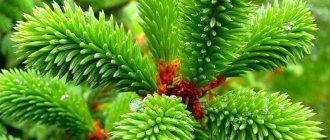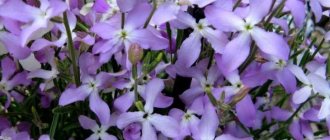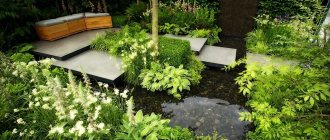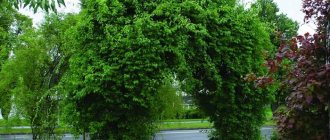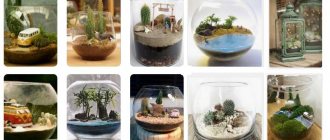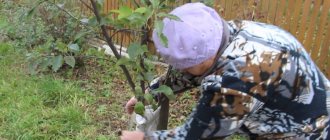- Lavender angustifolia
- Antennary
Evergreens are decorative all year round. First of all, these are conifers, which in summer effectively emphasize the beauty of the surrounding flowers, and in winter they solemnly turn green against the backdrop of white snow. But we decided to talk about deciduous trees, mainly of southern origin, which are also very popular in landscape design. We offer an overview of interesting types of evergreen plants for the garden with photos, names and brief descriptions, and ideas for creating compositions with their participation.
Experienced gardeners use topiaries to transform trees and shrubs into original topiaries
Evergreen perennials are represented by all life forms: trees, shrubs, subshrubs, shrubs, herbaceous plants.
Strawberry tree (Arbutus unedo)
It is a small, attractive tree with bell-shaped flowers and beautiful red fruit in the fall. As it grows, it often forms a remarkable multi-stemmed structure. Grows easily in medium, acidic, moist and well-drained soils. It is practically not susceptible to diseases and pests, but it is necessary to monitor the appearance of aphids or spots on the leaves.
What are the advantages of a flower garden without flowers?
In traditional gardens, the variety of greenery serves, by and large, only as a background for the brighter elements of the composition, a contrast that is designed to favorably emphasize the charm of floral splendor. Meanwhile, by allowing non-flowering plants to play the first violin in the symphony of your flower garden, you will receive a decorative element of the garden that is unique in its beauty. What are the advantages of such a flower bed?
1. All-season. Not every annual or perennial can boast the ability to bloom throughout the entire season. An incomparably larger number of crops are capable of blooming only during a certain period, which is usually limited to one to one and a half months. At the same time, the use of plants that stand out for their shape or texture will allow you to create compositions that will look presentable for most of the season.
2. Richness of forms. The high decorativeness of flower beds created without the use of flowering plants is achieved through a wide range of shades, shapes and textures and allows you to reproduce complex landscape compositions.
3. Easy to care for. Flowering plants require more attention than decorative leafy crops. High decorativeness combined with undemanding nature make flower beds made from non-flowering plants an ideal solution for people who cannot devote a large amount of time to their garden.
4. Versatility in application. Monochrome compositions allow you to effectively emphasize and highlight or, conversely, hide and shade other elements of the garden: paths, gazebos, outbuildings, fences, etc.
One of the compositions of the Bernardine Garden (Vilnius) clearly shows that the right combination of plants helps to revive the landscape even in late autumn
It is not surprising that with so many positive qualities, flower beds without flowering plants not only do not lose their popularity, but are also becoming more and more relevant. Low-maintenance “monochrome” compositions enjoy equal success both in urban landscaping and in arranging small private flower beds.
- Landscape design trends 2021 – what’s relevant today
Don’t know how to decorate your summer cottage in a new way? Famous designers will advise and show you!
Arizona cypress (Cupressus arizonica)
The tiny leaves look like scales and come in different shades of green on different varieties, including gray-green and blue-green.
The trees thrive in full sun and well-drained soil, as well as in hot, dry conditions. It grows at a moderate pace, adding from 30 to 60 cm per year and reaches a height of up to one and a half meters.
Cupressus arizonica requires a location that provides sufficient direct sunlight.
Can grow in acidic, neutral or alkaline soil. They tolerate clay, loam or sandy soils well, but they must be well drained. It will grow better if it is watered regularly, or better yet, irrigated.
Interesting tall garden flowers perennials
Tall herbaceous perennial flowers are enriched with their diversity; we suggest getting acquainted with the most interesting and popular representatives.
Perennials not only last for several years, but can also produce colorful flowers for two months or longer.
Amazing shade-loving perennials Phlox
Phlox are tall, shade-loving perennial garden flowers that are perfect for decorating original flower beds. They are planted in the central places of the compositions, and low-growing representatives are seated around the perimeter. Thanks to this combination, it will be possible to create truly attractive landscape elements. These shade-loving perennials will look great in the center because they are not prone to lodging and are able to maintain their shape perfectly.
The color of the petals varies from white to purple. The Neon Jade variety is very popular. He will delight you with white and green flowers. These flowers are up to 70 centimeters in height. Plants prefer sunlight; they react negatively to increased levels of moisture in the soil.
Another attractive variety is “Cyclamen”. It has large flowers, and the plant height is up to 90 centimeters. The shade of the petals is deep red, but with an interesting miniature crimson eye.
You might be interested
Choosing purple perennial flowers for your garden
Red perennials: the best plants to grow in the garden
Perennial shade-loving flowers and plants for the garden: a selection of the best plants
Cardiocrinum gigantea
In summer, the Giant Lily (Cardiocrinum giganteum) will unforgettably decorate your flowerbed when huge fragrant white lily flowers appear on the stems, the height of which can reach 3 meters.
Photo of Cardiocrinum gigantea (commons.wikimedia.org)
The leaves are large and heart-shaped. Requires semi-shaded, moist forest conditions. Small side bulbs take several years to reach flowering. This impressive plant needs the care and attention of an experienced gardener. It thrives best in coastal areas with a cool summer climate.
Stunning Dahlias
Another tall perennial flower is the Dahlia. They can be either annual or perennial. The color of the petals is different, just like the shape of flowering plants. An interesting variety “Duet”, which grows up to 1 meter high, and the volume of open buds is up to 18 centimeters. A special feature of this variety is its interesting color - bright, saturated (burgundy, orange, red), with a delicate white tip at the end.
Photo of a giant variety of Dahlia imperialis (Dahlia imperialis)
Another extraordinary variety of Dahlia majestic is Dahlia imperialis. Nodding flower heads 7.5-15 cm wide with rayed flowers. They can be painted in yellow and red shades. The height of bushes in nature reaches 10 m, garden plants grow up to 2 meters. Abundant flowering directly depends on the conditions in which the plants are grown. To get lush flower beds with original buds, you will need to fertilize and systematically water the perennials.
Dahlia lovers should also pay attention to the “Nallmark” variety. The buds are colored blue or light purple. The variety is distinguished by strong peduncles that are firmly held on the stems. Each bud has a diameter of 5 centimeters. Such flowers are very popular both for decorating gardens and for cutting and arranging original bouquets.
Incredible tall perennials Delphiniums
An excellent choice of tall perennials is the use of excellent Delphiniums in different colors. This summer garden classic will brighten up your garden in shades of blue, purple, white and pink. Thanks to this variation in shades, you can decorate your landscape design with different colors of the rainbow. The height of such bushes is up to 80 centimeters. The flowers are collected in cone-shaped inflorescences. Flowering usually occurs in July and August. The culture is very resistant to low temperatures, so it does not need shelter.
Exquisite Mallows
For those looking for tall perennial flowers along the fence, we recommend paying attention to Mallows. These are common flower representatives that are also found under the names hollyhock, mallow, and kalachik.
There are more than 30 varieties of such crops, including a huge number of perennial representatives. The most popular specimens are musky and wrinkled mallows. The height of the first varieties is up to 1 meter, their shades are soft pink. Each flower has a diameter of up to 5 centimeters. The second variety of flowers reaches a height of up to 2 meters and is distinguished by beautiful yellow petals. The crinkled look looks great as a hedge, instead of using decorative fences. This tall yellow perennial is a great addition to interesting flower arrangements.
Stunning Lupins
Lupins are charming representatives that are often found in garden art. In addition to its visual qualities, this flower is also in demand due to its unique soil improvement capabilities. If you chop the stems and embed them in the soil, aeration will significantly improve, and the soil itself will be enriched with organic matter.
Growing Lupines is not difficult. The main thing is to choose a site where there will be no winds. Lupines bloom in June and last for 30 days. The shades of the petals can be yellow, there are also red, blue and purple options.
Spiny Mordovnik
Mordovnik is a prickly plant that can captivate both people and insects with its beauty. This crop is a sought-after peduncle, which is distinguished by straight stems and spiny leaves. The height of the specimen is from 50 cm to 2 meters. The flowers are very interesting, have a tubular shape, a beautiful blue, dark blue or white color. The inflorescences cannot but attract attention, since visually they look like prickly balls in which a hedgehog seems to be hiding.
Yew (Taxus)
Yews are coniferous trees, so instead of flowers they produce cones (along with red berries). They are characterized by evergreen needles and a wide range of sizes and shapes, as well as a fairly rapid growth rate that slows down as the plant matures. It is best to plant them in spring or fall.
Soil type and PH – well-drained loam of medium moisture, neutral.
Balsam
This decorative flower is incredibly popular due to its unpretentiousness, almost constant flowering and easy propagation.
People call it affectionately the sparkle, impatiens or evergreen. Having appeared in Europe at the beginning of the 16th century, it was subsequently quite quickly spread throughout the world.
Its branched, succulent stems, depending on the variety, reach a height of fifteen to fifty centimeters. And the fleshy leaves with wavy edges are green-red, green or bronze in color.
Spruce (Picea)
Spruce has about 35 species of the genus Picea. Typically tall and thin, conical or cylindrical in shape. They have dark green or blue-green needle-like foliage with cones that fall off after pollination.
They quickly grow to large sizes. Most spruce trees are easy to grow due to their tolerance to a wide range of growing conditions.
Easily adapt to various types of soil, including clay or sandy.
They tolerate drought well, but prefer evenly moist soil.
Spruce trees are preferable to grow in cooler climates. They can withstand warm summers, but cannot tolerate high humidity or extreme heat.
Begonia
The name of this floral and ornamental plant dates back to the 17th century thanks to the monk Charles Plumier. While collecting plants in the Antilles, he discovered six species of flower of incredible beauty with decorative leaves and flowers.
The monk named his discovery in honor of his best friend, the governor of the island of Haiti, M. Begon. At the moment, there are about a thousand species of this plant and more than two thousand hybrids in nature.
Begonia is light-loving, but it should not be exposed to direct sunlight. Due to the fact that the plant is tropical, it requires high air humidity.
Douglas fir (Pseudotsuga menziesii)
This tall coniferous tree can reach a height of 120 cm to 90 meters, but there are smaller varieties available for the home landscape. As it grows, the Douglas fir takes on a pyramidal shape.
Douglas fir does not like hot and dry winds, but thrives in moist soil and humid climates. However, wherever you plant it, it should have full sun.
The ideal soil for this tree is acidic loam with drainage.
It is best not to trim a fir unless it needs to be trimmed from damaged, diseased or dead branches.
Evergreen shrubs enliven dull winter landscapes with their lush greenery. Some spring-blooming specimens produce colorful berries in the fall, making them attractive year-round.
Vertical gardening - from idea to implementation, choosing options according to budget and attractiveness (photo + video)- Vertical flower beds - basic principles and rules for choosing plants and arranging a suburban area with your own hands
Decorative grass - 140 photos of original design. Review of the best varieties of grass for the garden, instructions, reviews, videos + gardener recommendations
However, most of the evergreen shrubs featured here are prized for their resilient foliage and ability to bloom in cold climates, where the display of their winter greenery is most welcome.
What is an evergreen shrub?
It has the following features:
- less than 450 cm in height;
- several stems growing from the same point in the ground;
- responds well to pruning and care;
- has year-round foliage.
Tamarisk
Another lovely ornamental plant, shown in the photo, is beautifully called Beadweed or God's tree. Tamarisk took its scientific name from the Tama Riz River, which flows in the Pyrenees Mountains.
Bisernik mainly grows in deserts and sand dunes. It can be found in Africa, Asia and southern Europe.
This tree has more than fifteen species, and in the Caucasus it rises to a height of over six hundred meters. Deciduous or evergreen shrubs grow in a bush-like manner, reaching a height of one and a half to twelve meters. Their trunk, as a rule, is no thicker than half a meter.
Its crown has many twig-like stems, on which small leaf blades that look like scales are alternately located. Their color can be light or dark green, as well as emerald blue.
Leucothoe
It is a hardy and disease-resistant shrub that requires minimal special care.
The leaves have a leathery texture and their dark green color turns to shades of purple and bronze in the fall. Creamy white bell-shaped flowers add interest to this beautiful shrub, ideal for shady gardens.
The flowers are slightly fragrant, with a slight honey-like scent that attracts pollinators such as butterflies and bees, making this plant desirable and attractive in the garden landscape.
Overall, this evergreen has a pleasing array of seasonal garb, from young, bright green leaves in early spring to white flowers tinged with pink in late spring and early summer, to its autumn transition to deeper bronze and purple flowers.
Watering the site - types and types of systems, main differences and features, rules for selection and installation, as well as recommendations for operationOrnamental plants - 140 photo options. Review of the most popular plants with names and descriptions. Gardener's recommendations + reviews
Boxwood: planting, care, growing in open ground, propagation. Full description of the plant from A to Z. More than 100 photos of evergreen shrubs
Prefers medium, slightly acidic and well-drained soil.
Which evergreens should you plant in your garden?
Evergreens are beautiful all season long. The year-round greenery in many gardens and parks is mainly associated with coniferous trees. When the leaves fall, conifers begin to play first fiddle.
Pines, fir trees and junipers look great against contrasting white fluff, as well as in a variety of combinations of both coniferous and deciduous vegetation. But are they the only ones that enliven the gray surroundings with their greenery from November to March? In winter, not only conifers, but also evergreen deciduous plants are of great importance in the garden.
Beautiful garden all year round with your own hands
Coniferous plants
Planting coniferous trees is perhaps the simplest type of building a green garden in the autumn-winter period. Yellow pine is a good proposition for anyone who doesn't like the classic look of the main species. It is characterized by much longer needles, and their shape on the branch resembles a paint brush. Silver spruce will also add a personal touch to your garden. Even in winter, its shoots remain blue with a silvery sheen that blends perfectly with the surrounding snow.
However, in addition to the popular junipers, thuja and yew, new varieties of these shrubs and many other types of coniferous trees have appeared.
Most Popular Evergreen Deciduous Plants
You should remember not only about conifers, but also about deciduous species. And not only about popular dyes, ivy or rhododendrons (which can withstand even quite severe frosts), but also about lesser-known evergreen deciduous trees that are not afraid of our winters.
Boxwood
One of the most popular and most readily grown evergreen shrubs. It owes its popularity mainly to its high ornamental value and low cultivation requirements. Evergreen boxwood tolerates pruning well and has low habitat requirements, so growing it is not a hassle. However, it should be remembered that in the coldest regions of the country, delicate ornamental varieties can freeze, so plants should be covered for the winter.
Unfortunately, a serious threat to boxwoods is the boxwood moth - a very dangerous and relatively new pest that does not yet have natural enemies, and combating it and protecting boxwoods is difficult.
Pyracantha
A deciduous shrub, which in winter is decorated with small round fruits of intense yellow, orange or red color. Bright, spherical, yellow, orange or bright red fruits, collected in clusters, are the most valuable decoration of the bush. The fruit remains on the bush for the winter and is readily eaten by birds. The leaves are dark green, turn brown in cold winters, and sometimes fall off. In mild winters they can remain on the bush almost until the end of winter.
It is best to plant in a warm, sunny and sheltered location. It tolerates drought well, but does not tolerate transplantation. An excellent plant for a low hedge.
The pyracantha bush is decorative almost all year round. It can be planted singly or in groups of one or more varieties with different fruit colors. Suitable for hedges. The plant tolerates pruning well, which allows the shrubs to be given a variety of shapes. This is an interesting backdrop for the perennials planted before it.
Mahonia vulgaris
An evergreen shrub with dark green, shiny, leathery leaves that turn reddish-brown in autumn.
Mahonia flowers appear in the spring, followed by dark blue clusters of fruit in the summer. This plant is also called Oregon grape. the fruits of which can be eaten. Mahonia is best planted in light shade and sheltered from the wind. Suitable for planting under trees.
It does not tolerate drought well, so the substrate in which it grows must be constantly slightly moist. In colder parts of the country, the plant may freeze slightly, but in the spring it usually recovers well from damage.
Euonymus
A shrub with many varieties, differing in leaf color. Prefers moist and fertile soils and places protected from the wind.
Euonymus is a must-have shrub. They are beautiful, versatile and have low requirements. They keep their not too large, but colorful leaves throughout the year. Most often, the leaves are painted white, yellow or cream, but there are also varieties with pink accents. The species are similar to each other, but have many varieties, which differ mainly in the size and color of the leaves. Their flowers are not very noticeable, nor are their fruits (although the fruits may be decorative).
Euonymuses can grow as small bushes, but can also climb or crawl along the ground. They have no special requirements for growing. Although they grow best in fertile, fairly heavy and moist soil, they will cope with any relatively typical soil. They also tolerate temporary droughts. Many varieties tolerate cold well.
Holly - holly
It is an evergreen shrub that is increasingly being cultivated. Unfortunately, in our country it is rare to see one of its most decorative species, the holly (in winter it is covered with red fruits, which are used as a decorative motif at Christmas), because the plant does not tolerate low temperatures (down to about -20 ° C). ) and dries easily.
You can try only in the warmest regions of the country, hoping that the winters will be mild. Other species such as Meserva holly or American holly will fare much better in our gardens than holly.
Japanese pieris
Pieris are very attractive shrubs. Not only do their leaves last all year round, but they can be both green and colorful. The young shoots that appear in the spring are also colorful. Pieris have beautiful flowers - white or pink, bell-shaped, collected in dense inflorescences.
The bushes grow up to 2-3 m in height, but there are also shorter varieties. These are plants that love acidic soil and secluded, protected places. They tolerate frosts down to -18ºС well.
Evergreen herbaceous plants
Few people know that evergreens are also found among perennials with herbaceous shoots. However, they do not always retain their beauty in winter. Most of them are creeping and carpet perennials, such as: common periwinkle, large periwinkle, creeping violet, fragrant violet - partly evergreen, etc.
Hellebores
Clumps of green leaves will also become hellebores in winter. There are quite a few different types of these perennials. Some also flower in winter, although in practice it is quite late autumn or very early spring (there are also species that flower in late spring). The leaves lose their beautiful appearance only at the end of spring, but new leaves quickly replace them, even at a time when other green plants are already present.
Hellebores feel best under deciduous trees and shrubs, on fertile calcareous (alkaline) soils.
sedum
Sedum has many types. Among them there are those that do not fade in winter and are resistant to frost. These are small plants with creeping shoots, so when planting them, keep in mind that they will not create an impressive composition. But on rockeries or on a lawn they will be ideal.
Bergenia
Bergenia is a beautiful evergreen perennial plant whose large leaves, depending on the species, turn brown or red in winter. The plant has low growing requirements and is quite tolerant, with the added benefit of the beautiful, usually pink flowers that appear in the spring.
Bergenias love bright but not very sunny places and can grow in partial shade. They prefer moist and fertile lands.
Japanese Runian
Japanese rune is an exceptionally graceful perennial plant. It is not tall (it grows up to 15-20 cm in height), but in good conditions it creates dense carpets. Because it loves shade, it is ideal for planting under trees and shrubs, especially deciduous ones. When their shoots are bare of leaves, we fully appreciate the charm of green marshmallows. It is also beautiful in spring when it blooms white. Runianka has dark green glossy leaves, but there are also varieties with white-green leaves.
Runianka is resistant to frost, disease and air pollution. But in order for it to grow well, there must be fertile, humus and necessarily moist soil, preferably slightly acidic.
Japanese skimmia
This is an exceptionally beautiful bush. In addition to having green leaves in winter, it also comes with flower buds that will develop in April. The flowers are small, but collected in larger inflorescences. They have a pleasant smell. In our conditions, these bushes are not large, but dense (they grow up to 1-1.5 m in height).
Skimmia is beautiful all year round. Unfortunately, it is best planted in warmer regions because it is not completely frost-hardy.
Iberis
The plant is bushy, small in size, and its leaves remain green all winter. Iberis does not have high growing requirements; in spring it is covered with numerous white flowers, so it should find a place in every garden.
However, in order for the plant to maintain its beautiful shape for a long time, it should be systematically rejuvenated by making a strong cut immediately after flowering.
Heather
This is an extremely attractive shrub. He is not tall, but willingly creates dense “pillows” from him. The shoots are densely covered with dark green small needle-like leaves that do not fall off in winter. An additional big advantage is that it blooms in winter too. If there is no frost, flowers may appear as early as February. Then the “pillow” ceases to be green, but becomes pink or white, because there are many colors.
Heathers are hardy, love sun and slightly acidic soil, but tolerate the conditions quite well.
Evergreen vines
The group of evergreen climbing plants is small. These include common ivy, which fortunately comes in many varieties, and possibly periwinkle.
Ivy
A very popular evergreen climbing plant, whose shoots grow up to 30 m in length due to climbing adventitious roots. The leaves are dark green, shiny, leathery. Grows best in partial shade and partial shade.
Excellent for fences and walls, and also as a ground cover.
Periwinkle
Common periwinkle is one of the least troublesome and beautiful plants. A low evergreen shrub, creeping along the ground, growing up to 30 cm in height. It has leathery, dark green leaves. Some varieties have variegated leaves and large purple-blue flowers. Grows best in semi-shaded areas. This is an excellent ground cover plant.
Periwinkle grows quite quickly, which must be taken into account when planting it. At the same time, it can create a beautiful green carpet in shaded areas where few plants grow well. It has low soil requirements but grows best in fertile humus soil.
Conclusion
Before choosing an evergreen plant, let's first think about the garden, sunlight, soil type, acidity, soil moisture to best suit the existing habitat for the selected plant. Remember that these plants require special care not only in the summer, but throughout the year.
Cherry laurel (Prunus laurocerasus)
It is a wide, dense, spreading shrub that eventually reaches a height of up to 5 meters and a spread of up to seven meters.
It has shiny, oblong, dark green leaves - up to 15 cm in length. The foliage is evergreen, without autumn color. Tiny cupped creamy white flowers in vertical clusters (inflorescences up to 13 cm long) bloom from the leaf axils in April-May. The flowers have a powerful aroma. They give way to somewhat inconspicuous black drupes that ripen in midsummer. This fruit is mostly inedible for humans (bitter aftertaste), but is loved by local birds.
Pest resistance is better than most other species of the genus Prunus. Vulnerable to powdery mildew and root rot.
Silver flower garden style
In nature and in cultivated plantings you can often find plants with silver-gray leaves. In our country, these are thickets of willow or coltsfoot, sea buckthorn gardens, in warm climates - olive and cypress groves, lavender fields, rosemary plantings, sedum and milkweed, as well as “gray-haired” tub plants.
It is generally accepted that silver-blue compositions are intended, first of all, to create gardens in the Mediterranean style - silver, cheerful and cool. But silver is also suitable in gardens of other styles. In regular compositions, symmetrical plantings of blue spruce trees or trimmed hedges in gray tones are sometimes used. Silver-blue colors are absolutely irreplaceable if your garden is decorated in Art Nouveau, avant-garde, neoclassical and neo-Renaissance styles. Landscape style also fully allows for the presence of silver in landscape compositions.
When creating a flower garden in a “marine” style, the obligatory symbolic presence of water is implied, which is depicted with the help of silver, light blue, indigo, white, and gray shades of leaves and flowers. Mixborders of coniferous and decorative-leaved trees and shrubs often include plants with silver-colored leaves and needles.
Flower beds of annuals in any style, especially carpet flower beds, where the pattern is clearly defined, cannot do without these cool tones. Mixborders of perennials, which use a wide variety of plant forms with bright colors, often include silver-gray shades to balance the composition. They serve as a buffer between poorly combined colors, fill it with light, form poles of calm, and make other colors richer and richer. Rock gardens and rockeries often contain silver tones.
The colors white, gray and silver are close in perception - they are neutral and closer to the cold range, but they always attract attention. Gray color is ambiguous; it has unique properties: it fills the garden with light and visually expands the boundaries of the garden or mixborder, which is especially important in small gardens. It softens cold colors (blue, indigo) and combines light colors (pink, cream, white, lilac, apricot), and red, yellow, orange, purple tones begin to literally shine in the presence of gray, showing their expressive character.
Like white, silver has many shades depending on the environment: it can be yellowish and greenish, pinkish and bluish, “gray-haired” and almost white. Depending on the lighting, weather and texture of the leaves, it can be sparkling and dull, matte and metallic, cold and warm, modest and elegant, neutral and noble, magical and mysterious. This play of colors will never seem boring or monotonous! In a silver garden or flower garden, various and correctly selected accessories are extremely important: in the form of gray-blue balls, silver moths, benches, supports and obelisks for climbing plants, galvanized, tin and tin containers, garden sculptures.
Azalea
Is there a more welcome sight in spring than a blooming azalea bush? These shade-loving plants can bring delightful color to every corner of the spring garden. Many species can grow up to 350 cm in height, with extraordinary beauty in spring.
The color range is impressive - from white to pale pink, from red to purple. Most azaleas bloom in mid-spring, but some bloom earlier or later than others, so it's easy to choose a variety for your design needs.
Azaleas like acidic soil. This explains why seedling pots typically use peat moss as a planting medium. The soil should also have good drainage and good fertility with plenty of organic matter (compost, shredded leaves, etc.). Azaleas do best with natural mulch, such as pine bark mulch.
They need water to bloom and spring rains usually alleviate this problem. However, if the spring is dry, additional watering may be beneficial.
Living fence - the best ideas on what to make a hedge from at your summer cottage. Many photos of ready-made options with exclusive designs + instructions- Trimming bushes - the basics of choosing the right plants and forming the right shapes, selecting tools (photo + video)
Landscaping a site - basic principles and rules for creating a beautiful site with your own hands
The winter hardiness of azaleas varies and therefore it is very important to carefully select the plant variety and its planting location.
If it is too cold, the buds may not form, and if it is too hot, the flowers may burn from excessive temperature exposure.
Mold can be detrimental to azaleas and, to ensure adequate air circulation, do not plant them too close to other large shrubs.
Rhododendron
These shrubs and trees are divided into deciduous, semi-deciduous and evergreen. According to various sources, this genus has more than a thousand species, including azaleas, popular among gardeners.
Literally, “rhododendron” is translated as “tree with roses” or “rose tree.” The reason for this name lies in the fact that azalea flowers look very much like roses.
This plant loves the climate of the coastal sea or river zone, therefore in the wild Rhododendron is most common in the south of China, the Himalayas, Japan and North America.
Some species can reach a height of more than three hundred centimeters, and the flowers vary in shape, size and color.
It blooms in large clusters of flowers that have an incredibly beautiful pink or purple hue.
Evergreens - a complete list with descriptions and recommendations from a gardener- Vertical gardening - from idea to implementation, choosing options according to budget and attractiveness (photo + video)
- Vertical flower beds - basic principles and rules for choosing plants and arranging a suburban area with your own hands
It requires warm temperatures and therefore can freeze in winter. And only a few varieties are adapted to the climatic conditions of the middle zone.
Japanese Pieris (Pieris japonica)
An ornamental shrub that is attractive all year round. In late summer, reddish buds appear for next year's blooms. During the winter months, these beady buds contrast with the evergreen, glossy foliage.
Pieris japonica is an early blooming flower; it blooms for about two weeks in late winter - early spring. The white or pink flowers resemble lily of the valley flowers, but without the strong scent.
Warning—the leaves, flowers, and by-products (honey) of this shrub are highly toxic to humans and pets. Like rhododendron, it contains serotoxins, which if ingested can be fatal. For this reason, Pieris japonica is not recommended if children are playing in the yard or pets are wandering around.
These shrubs prefer shady places where they will be protected from drying winds, and like to take root in acidic soil.
Well-draining soil is preferred to prevent dangerous fungal infections, and this species is susceptible to the same diseases as azaleas.
Fungal diseases mainly spread in humid weather. Therefore, proper spacing between bushes is critical for good air circulation and plant health. Shrubs should be placed at a distance of about 180-210 cm from each other, taking into account their size in adulthood.
Pieris japonica prefers full sun rather than partial shade. In warmer climates, it should be planted in a location where it is protected from the hot afternoon sun.
The soil should be rich in organic matter and moist but well-drained; This shrub does not grow well in wet soils.
Pieris japonica is an acid-loving plant that does not tolerate alkaline soils. Before planting, you should check the soil pH and add a special fertilizer for azaleas, camellias and rhododendrons that contains sulfur to raise the pH level.
In the absence of rain, the shrub needs regular deep watering about once a week. It is necessary to moisten the soil to a depth of 8 cm.
A layer of pine needle mulch about 5-8 cm thick helps retain moisture in the soil.
Decorative garden plants
Planting ornamental shrubs can transform a former construction site or wasteland into a luxurious oasis in a few hours, if they were purchased in pots already grown. After purchase, they are replanted with a lump of earth.
In this case, all conditions regarding the characteristics of the soil and the degree of frost resistance should be taken into account. In view of this, you should choose those plants that will feel most comfortable on your site.
All trees and shrubs are divided into three types: beautifully flowering, evergreen and decorative deciduous garden plants.
Almost every person is familiar with such flowering ornamental shrubs as white acacia, perennial rose hips, and medicinal fragrant lilacs. Let's talk about other garden plants that have a more exotic appearance.
Evergreen boxwood (Buxus sempervires)
The genus Buxus includes about 70 species of slow-growing, broad-leaved evergreens. Most garden forms are cultivars or hybrids of two species: B. sempervirens and B. microphylla.
Boxwoods are typically large shrubs or small trees, but most varieties used in modern landscaping are dwarf varieties such as B. Sempervirens 'Suffruticosa' and Buxus sinica var. Insularis.
Reaching a mature height of just 60cm, these dwarf boxwood shrubs are prized for their thick, light green leaves and round, compact shape when growing.
Boxwood is best planted in loamy soil in full sun or partial shade, preferably in an area better protected from the wind. Their roots are shallow, so the soil must be protected from heat.
There should be an 8cm thick layer of organic garden mulch around each plant. The mulch should be 5cm from the trunk and about 30cm outwards around the entire circumference if space allows. If this process is carried out close to a bush or tree, pests can be attracted.
Boxwood tolerates full sun to partial shade, but is preferably planted in dappled shade during the hottest part of the day. Covered by trees, dwarf boxwood roots will benefit from cooler soil temperatures.
Boxwood bushes require well-drained soil or they will suffer from root rot. Although they can tolerate soils with lower pH, a soil pH in the range of 6.8 to 7.5 is preferred.
For the first two years, boxwood requires weekly deep watering, otherwise the moisture will not reach the main root system. With deep watering every 2-4 weeks, mature plants will grow well.
In the spring, before new shoots appear, the bushes must be fertilized with universal fertilizer.
The best evergreens for the garden
Evergreens are the foundation of any modern garden. In summer they are an excellent base, background or green structure for various compositions, in winter they take over, becoming an attractive dominant in a snowy landscape or lifting us up with their greenery on depressive, gray, snowless winter days.
Evergreen shrubs are, according to most botanical definitions, all plants that do not lose their leaves in winter or lose only part of them. These plants do not hibernate and their appearance does not change much throughout the year. Sometimes in winter their leaves change color a little, some freeze slightly, but most remain the same.
Evergreens add beauty to any garden all year round. They add color to dark corners, protect from nosy neighbors, and add charm with their beautiful leaves.
An evergreen plant is not always frost-resistant
You can buy many plants in garden stores that are supposed to be evergreens, but it often turns out that they did not survive the winter in the garden. In fact, many of them are quite sensitive to our climate conditions. Therefore, when choosing evergreen deciduous plants for the garden, not only their frost resistance is important, but above all their resistance to adverse weather conditions in winter.
That is, to frosty winds (drying out, frost resistance), unexpected frosts (sharp temperature changes), physiological drought (water that the plant cannot collect - for example, when the substrate is highly saline or when it is frozen), strong sunlight (increased transpiration).
- Of course, it is best to choose native plants that are native to our landscape, but there are a number of beautiful plants that were once introduced to our climate and have been successfully grown in gardens. However, in the case of these plants, it is necessary to take additional care measures in the autumn-winter period.
- A good solution is to plant ground cover plants to provide a natural blanket during snowless winters. You can also try mulching the soil with bark to reduce soil freezing and evaporation.
- A good solution after planting young plants is also a winter shelter (white agrotextile), because some specimens may freeze.
- You can try planting them in quiet corners of the garden, sheltered from frosty winds, or making special screens for the winter. It happens that in extremely unfavorable weather, even those specimens that have not been sheltered for many winters suddenly freeze overnight. This may be due to the general weakening of the plant in summer (drought, pests, diseases, lack of nutrients), so we will take care of them in particular.
When is the best time to prune evergreen bushes?
As a rule, needle bushes are pruned in early spring - towards the end of the dormant period and before new shoots appear. Pruning plants at this time allows enough time for new shoots to appear and also allows them to get stronger until next winter.
But often broadleaf shrubs (and some needle-bearing varieties) require a different approach. For example, if they are flowering shrubs (that is, plants valued for their flowers), you will have to wait until after the flowering period to prune them. Otherwise, the more flower buds that are removed during the pruning process, the less pleasure will be obtained from the sight of flowering plants.
And what’s the point of growing such a bush if you can’t admire its flowers? In particular, pruning azaleas and rhododendrons after they have finished flowering makes much more sense than pre-pruning them.
Decorative indoor plants
Growing beautifully flowering plants in pots began to be practiced back in the era of the Great Geographical Discoveries. Today, caring for indoor plants is a passion for millions of people around the world.
Flowers vary in shape, color and foliage characteristics and may be of local or distant origin. In any case, in the bustle of the city, they remind you of the enchanting delights of nature.
Start small
The first and, perhaps, the most important technique that is used when creating flower beds without flowering plants is, of course, a game of contrast. Combinations of leaves of different sizes, textures, shapes and colors allow you to create real landscape paintings. However, not every novice gardener can achieve the desired effect using all these characteristics. Lack of experience can play a cruel joke on a beginner, so at first it is better to focus on using one or two techniques.
